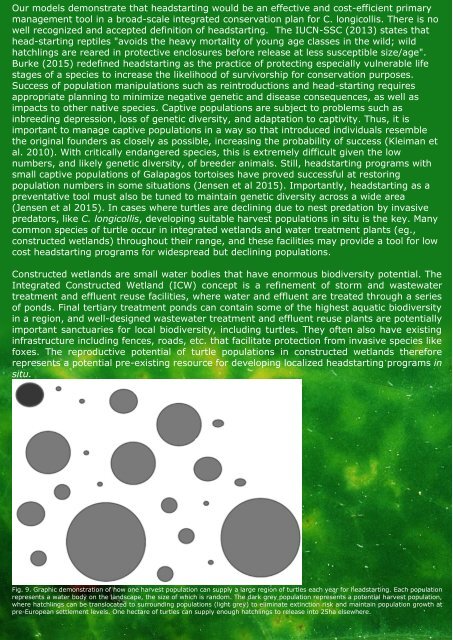Preventing Freshwater Turtle Extinctions
Critically Evaluating Best Management Practices For Preventing Freshwater Turtle Extinctions
Critically Evaluating Best Management Practices For Preventing Freshwater Turtle Extinctions
- No tags were found...
You also want an ePaper? Increase the reach of your titles
YUMPU automatically turns print PDFs into web optimized ePapers that Google loves.
Our models demonstrate that headstarting would be an effective and cost-efficient primary<br />
management tool in a broad-scale integrated conservation plan for C. longicollis. There is no<br />
well recognized and accepted definition of headstarting. The IUCN-SSC (2013) states that<br />
head-starting reptiles "avoids the heavy mortality of young age classes in the wild; wild<br />
hatchlings are reared in protective enclosures before release at less susceptible size/age".<br />
Burke (2015) redefined headstarting as the practice of protecting especially vulnerable life<br />
stages of a species to increase the likelihood of survivorship for conservation purposes.<br />
Success of population manipulations such as reintroductions and head-starting requires<br />
appropriate planning to minimize negative genetic and disease consequences, as well as<br />
impacts to other native species. Captive populations are subject to problems such as<br />
inbreeding depression, loss of genetic diversity, and adaptation to captivity. Thus, it is<br />
important to manage captive populations in a way so that introduced individuals resemble<br />
the original founders as closely as possible, increasing the probability of success (Kleiman et<br />
al. 2010). With critically endangered species, this is extremely difficult given the low<br />
numbers, and likely genetic diversity, of breeder animals. Still, headstarting programs with<br />
small captive populations of Galapagos tortoises have proved successful at restoring<br />
population numbers in some situations (Jensen et al 2015). Importantly, headstarting as a<br />
preventative tool must also be tuned to maintain genetic diversity across a wide area<br />
(Jensen et al 2015). In cases where turtles are declining due to nest predation by invasive<br />
predators, like C. longicollis, developing suitable harvest populations in situ is the key. Many<br />
common species of turtle occur in integrated wetlands and water treatment plants (eg.,<br />
constructed wetlands) throughout their range, and these facilities may provide a tool for low<br />
cost headstarting programs for widespread but declining populations.<br />
Constructed wetlands are small water bodies that have enormous biodiversity potential. The<br />
Integrated Constructed Wetland (ICW) concept is a refinement of storm and wastewater<br />
treatment and effluent reuse facilities, where water and effluent are treated through a series<br />
of ponds. Final tertiary treatment ponds can contain some of the highest aquatic biodiversity<br />
in a region, and well-designed wastewater treatment and effluent reuse plants are potentially<br />
important sanctuaries for local biodiversity, including turtles. They often also have existing<br />
infrastructure including fences, roads, etc. that facilitate protection from invasive species like<br />
foxes. The reproductive potential of turtle populations in constructed wetlands therefore<br />
represents a potential pre-existing resource for developing localized headstarting programs in<br />
situ.<br />
Fig. 9. Graphic demonstration of how one harvest population can supply a large region of turtles each year for headstarting. Each population<br />
Spencer R-J et al. 2017 Critically Evaluating Best Management Practices for <strong>Preventing</strong> <strong>Freshwater</strong> <strong>Turtle</strong><br />
represents a water body on the landscape, the size of which is random. The dark grey population represents a potential harvest population,<br />
where <strong>Extinctions</strong>. hatchlings can Conservation be translocated Biology. to surrounding In Press. populations (light grey) to eliminate extinction risk and maintain population growth at<br />
pre-European settlement levels. One hectare of turtles can supply enough hatchlings to release into 25ha elsewhere.<br />
12


